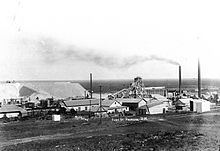Country Australia Financial year 2008-09 Company St Barbara | State Western Australia Production 82,795 Website St Barbara website Opened 1896 | |
 | ||
Coolgardie kalgoorlie gwalia gold mines 1976 outback western australia
The Gwalia Gold Mine is located at Gwalia, a few kilometres south of Leonora, Western Australia. It was originally established by Welsh miners in the late 19th century and Herbert Hoover, the later President of the United States, served as the mine manager in its early days from May to November 1898.
Contents
It is operated by St Barbara Limited. Apart from Gwalia, St Barbara also operates the Marvel Loch Gold Mine at Marvel Loch and owns the Tarmoola Gold Mine, which is placed in care and maintenance.
All three mines were previously owned by the now defunct mining company Sons of Gwalia Limited. Sons of Gwalia went into administration on 30 August 2004 and the company's gold mining operations were sold to St Barbara in March 2005 for A$38 Million, having been valued by the Sons of Gwalia directors at A$120 Million. While Marvel Loch was operational before and after the sale, the Gwalia mine was already placed in care and maintenance at the time of the transaction. A fourth mine, the Carosue Dam Gold Mine, ceased operation in June 2005 and has since been sold by St Barbara.
History
Established in 1896 as the Sons of Gwalia mine, it was named after an archaic Welsh word for Wales, Gwalia.
The Sons of Gwalia reef was discovered by three prospectors who worked it for a brief time. After selling out to George Hall for £5,000 the latter recouped his investment after only one month. In search for additional capital, Hall began negotiations with a London firm, Bewick Moreing, who sent Herbert Hoover, a 23-year-old mining engineer, to the site. Hoover recommended Bewick Moreing purchase the mine, which they did with a cash commitment of £100,000 on 17 November 1897. He suggested himself as manager of the project and successfully reduced costs at the mine by hiring Italian labour.
A fierce rivalry between Gwalia and neighbouring Leonora developed and a tram service was established between the two towns in 1903. From the 1920s, the town started to decline when external factors like the falling gold price started to affect the mine. On 21 December 1963, the gold mine at Gwalia closed and the town was reduced in population from 1,500 to 40. The Sons of Gwalia mining company was delisted for the first time on 4 February 1964. In 65 years of operation, the mine had produced 2,500,000 ounces of gold.
In the 1980s, a new Sons of Gwalia company, formed by the brothers Peter and Chris Lalor, descendants of Peter Lalor, started retreating old tailings before mining the old workings. In 1999, having concluded mining the Gwalia open pit, it started to develop an underground operation, passing through old workings by 2001.
On 4 September 2000, a flight to the Gwalia mine with seven SGW employees failed to land, instead continuing on to Burketown, where it eventually crashed, having run out of fuel. The pilot and the planes seven passengers were killed.
From 2001 onwards, the mine was part of the company's Leonora operations, after it acquired the Tarmoola Gold Mine through a merger with Pacmin Mining. Tarmoola is located 40 km north of the Gwalia mine.
In December 2003, the mine was placed in care and maintenance after known gold resources were exhausted.
After a rapid rise of the company, unauthorised gold and foreign exchange trading activities by chief financial officer Eardley Ross-Adjie in the year to June 2000, ended up costing Sons of Gwalia more than A$190 million. Sons of Gwalia went into administration on 30 August 2004, following a financial collapse, with debts exceeding $800 million after suffering from falling gold reserves and hedging losses. Sons of Gwalia was Australia's third-largest gold producer and also controlled more than half the world's production of tantalum.
St Barbara purchased the mine from insolvent Sons of Gwalia in March 2005 with a three-year plan to reopen it.
After a three-year redevelopment, production resumed at the mine in September 2008, with the first gold pour being carried out in October 2008. The Hoover decline, named after the late President, was at 1,191 metres below surface as of 30 June 2009. The plant currently continues to operate on a campaign basis, one week on, one week off.
Production
Production of the mine:
